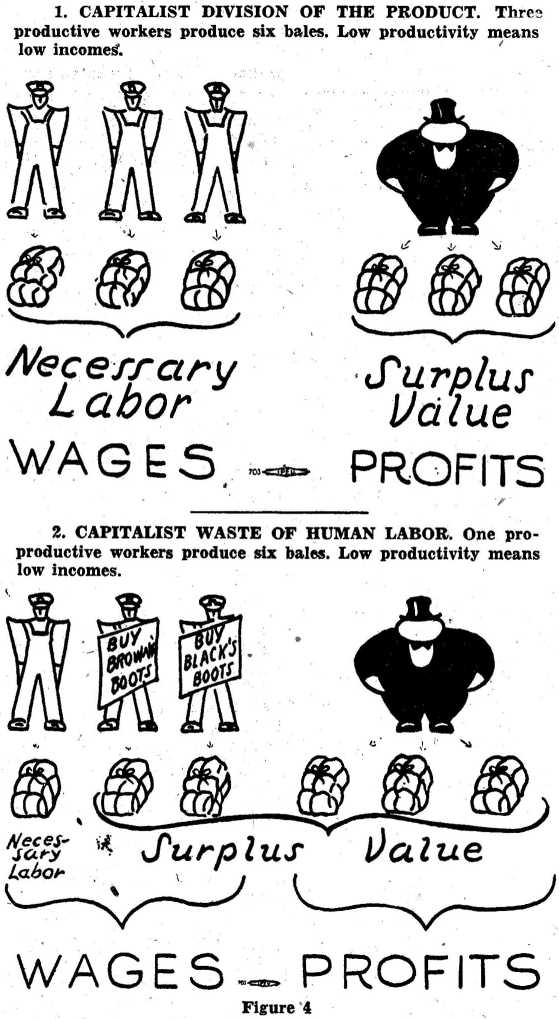
Main NI Index | Main Newspaper Index
Encyclopedia of Trotskyism | Marxists’ Internet Archive
From The Militant, Vol. X No. 38, 21 September 1946, p. 6.
Transcribed & marked up by Einde O’Callaghan for ETOL.
Last week we started to examine human labor which is wasted in commodity selling. The individual capitalist hires workers to get customers away from the other capitalists. It is necessary for the other capitalists to hire workers to get the customers back. But this selling labor produces nothing and is not necessary for society.
Along with commodity selling waste there is also a small amount of labor in real distribution, and this latter labor is useful and necessary. Capitalist economists, however, use the word “distribution” for both kinds of work. When they say “distribution” they are using one part of real distribution as a cloak to cover nine parts of sheer competitive waste.
Such waste has grown into a large factor in capitalism. Capitalist contentment with this state of affairs appears in the following statement by the president of the Curtis Publishing Company. His firm happens to publish the Saturday Evening Post and other magazines that make money from advertising.

|
“You probably will be surprised – most people are – to learn that over half of our working population is engaged in distribution and servicing things already made. And even with this large segment of our population already engaged in it, I believe that distribution offers greater opportunities to young men and women than any other phase of economic endeavor.” (Emphasis ours.)
A little over half a century ago the bulk of the workers were in production. Today over half are in non-productive labor, and the proportion of wasted labor keeps growing. As efficiency in production has grown, capitalism has put the population to living on the output of fewer and fewer industrial workers.
Figure 4 illustrates this process.
Part 1 roughly illustrates an early phase of capitalist division of the goods produced. The six bales of goods represent the total output of labor. This can be the output in any length of time we choose; let’s call it a week. The three productive workers produce the six bales, so each productive worker produces two bales.
Each worker needs one bale of goods a week to support himself and his family. This fraction of the output of his labor is necessary for the worker to live, so the Marxists call it Necessary Labor. Through the wage bargaining system, as we have seen, the workers get the product of that Necessary Labor as wages. The workers get enough to live on. Each worker in the diagram gets one bale of goods.
The rest of the output of the three workers, over and above the Necessary Labor, represents what Marxists call Surplus Labor or Surplus Value. In Part 1 of the diagram that comes to three bales and the capitalist keeps them as profit. Thus, the three bales of Necessary Labor are the same as tile Wages; the three bales of Surplus Value are the same as the Profit.
In Part 2 productivity has great increased. It now takes only one productive worker to produce six bales of goods. But still a worker is able to survive on one bale a week so his wages stay at one bale. The capitalist class, with a larger mass of surplus value, spends some of it hiring workers to compete for customers. So two workers are moved from production to unproductive labor, carrying sandwich boards saying: “Buy Brown’s Boots,” and “Buy Elack’s Boots.” They are still hard at work, but they produce no labor-value, and the capitalist must pay their wages out of surplus value.
At first glance it seems that the increase in efficiency has been swallowed up, and nothing has changed. Wages are no higher, the standard of living is no better; profits are no higher, total output is no higher. The only apparent change is in the transfer of more and more workers to unproductive labor.
In fact, the workers are robbed of more than appears on the surface. Here are three workers, each capable of producing six bales, but each getting only one bale. Together they do enough work to produce 18 bales, yet the national output still remains only six bales. The capitalists allow three bales as wages, take three bales as profit, and in effect, throw away 12 bales in non-production, by transferring two-thirds of the labor force to competitive waste.
All around us we see poverty although we know we could produce abundance. Marx’s law of labor-value shows why this is inevitable as long as capitalism remains.
Next Installment: More on Capitalist Waste
Main Militant Index | Main Newspaper Index
Encyclopedia of Trotskyism | Marxists’ Internet Archive
Last updated on 28 June 2021